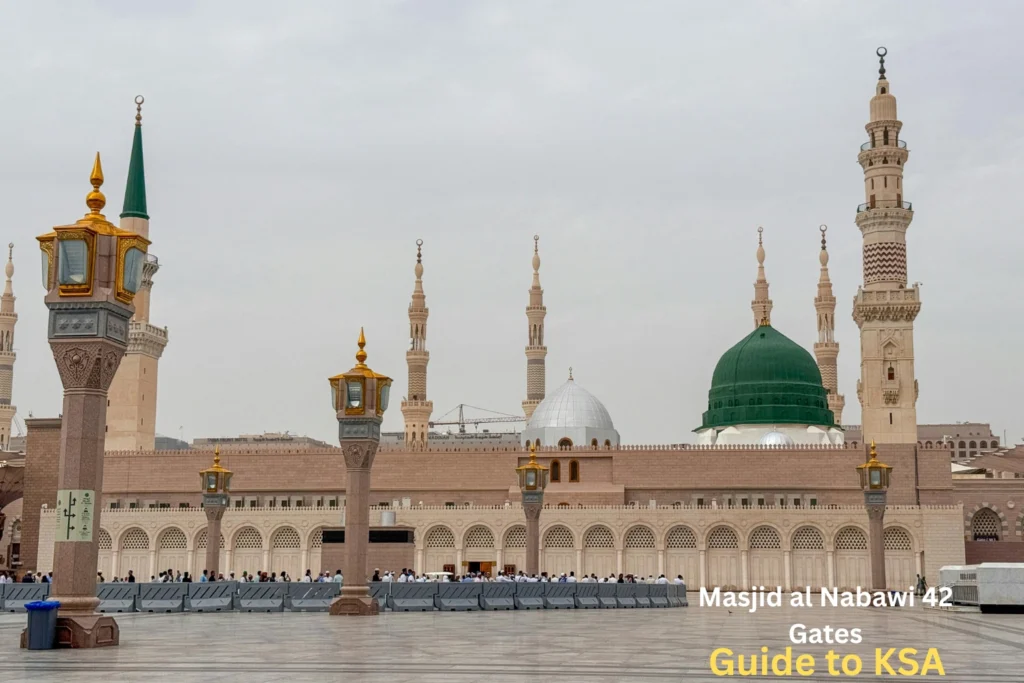Masjid al-Nabawi, the Prophet’s Mosque in Medina, stands as a sacred sanctuary that holds immense significance in the hearts of Muslims worldwide. At the very core of this revered structure lies a remarkable network of 42 gates of Masjid Al Nawabi, each with its own unique history, architectural features, and spiritual symbolism.
This comprehensive guide delves deep into the intricate details of these magnificent entryways, offering a profound exploration of their role in facilitating the devotion and connection of both men and women to this hallowed place.
Gates of Masjid al Nawabi Map
The 42 gates of Masjid al Nabawi are meticulously categorized into two distinct groups: those designated for men and those reserved for women.
Men’s Gates:
The majority of the gates, numbering 1, 2, 3, 4, 5, 6, 7, 8, 9, 10, 11, 15, 16, 17, 18, 19, 20, 21, 22, 31, 32, 33, 34, 35, 36, 37, 38, 39, 40, and 41, are exclusively accessible to the male congregation. These gates provide direct and convenient access to the various sections of the mosque, including the Raudhah (Prophet’s Resting Place).
Women’s Gates:
The remaining gates, numbered 12, 13, 14, 23, 24, 25, 26, 27, 28, 29, and 30, are designated for the use of female worshippers. These dedicated entrances ensure the comfort, privacy, and spiritual fulfillment of the women who visit Masjid al-Nabawi.
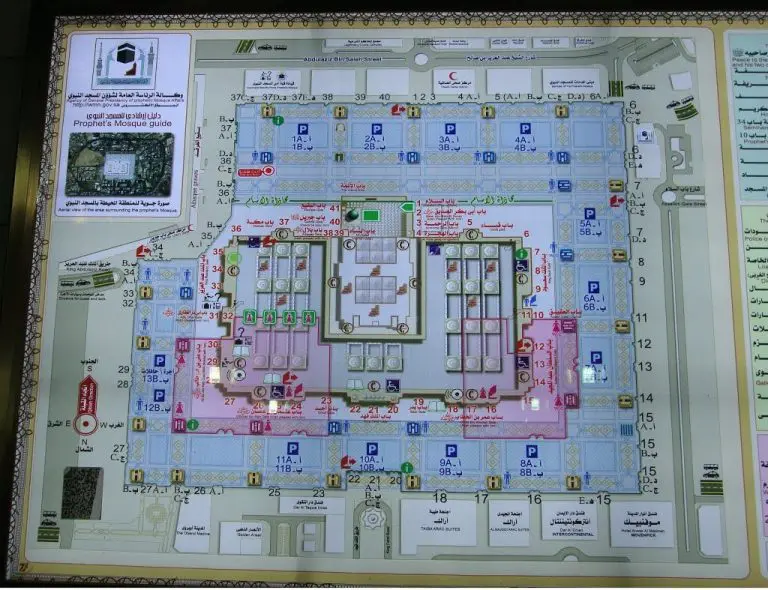
Exploring the Significance of the Gates
1. Bab as-Salam (Gate No. 1):
- The first gates of Masjid al Nawabi, built by Caliph Umar in 640 CE.
- Situated on the western wall, it has been relocated multiple times during expansions.
- Known as the “Door of Peace,” it is a primary entrance for men visiting the Raudhah.
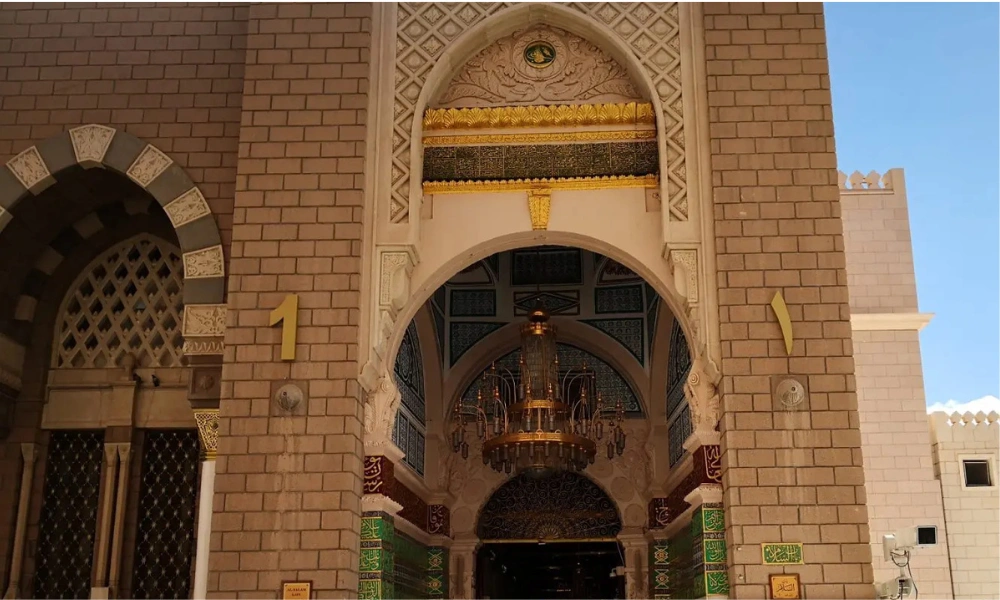
2. Bab e Abu Bakr Siddique (Gate No. 2):
- The second gate, named after the esteemed companion Abu Bakr Siddique.
- A smaller, intimate gate that has also been moved westward over time.
3. Bab ur Rahman (Gate No. 3):
- Installed by Prophet Muhammad ﷺ himself and later relocated.
- Also known as Bab-e Atiqa, named after the nearby house of Atiqa bin Abdullah bin Yazeed.
4. Hijrah Gate (Gate No. 4):
- A double-arched gate commemorating the Prophet’s Hijrah (migration) from Makkah to Medina.
- Initially had two portals, later expanded to four during the mosque’s expansion.
- Features a Hijri clock that rings at sunset.
5. Bab-e-Quba (Gate No. 5):
- Located in the direction of Quba village, this triple-arched gate is part of the King Fahad bin Abdul Aziz block.
6. 6 Gate of Masjid al nawabi:
- Provides access to the rooftop of Masjid al-Nabawi via an escalator.
7. King Saud Gate (Gates No. 7, 8, and 9):
- Named after King Saud bin Abdul Aziz, who commissioned the first Saudi expansion.
- Consists of two large and five small portals, with one of the six tallest minarets on its southern flank.
8. Imam Bukhari Gate (Gate No. 10):
- Located between the King Saud and King Abdul Majeed gates on the western side.
- Named after the renowned Islamic scholar Imam Bukhari, it provides access to the mosque’s library.
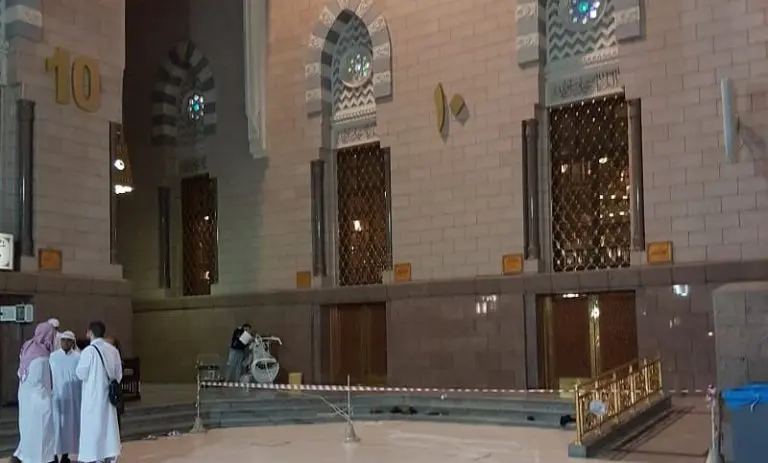
9. Bab Ul Aqiq (Gate No. 11):
- Named after the Wadi-e Aqeeq that lies along the western boundary of Medina.
- Surrounded by the dwellings of prominent companions of the Prophet ﷺ.
10. Bab e Sultan Abdul Majeed (Gates No. 12, 13, and 14):
- Named after the Ottoman Sultan Abdul Majeed, part of the first Saudi expansion.
- Incorporated into the mosque during the second Saudi expansion by King Fahad.
- Consists of five small and two large portals, with one minaret merging into Bab-e Omar ibn Khatab.
11. Bab Umar Ibn al Khattab (Gates No. 16, 17, and 18):
- Located on the northwestern corner of the main complex, with 18 portals.
- Provides access to the mosque’s library.
12. Bab Badr (Gate No. 19):
- A single-portal entrance on the northern flank, between the Bab e Malik Fahad and Babe Umar Ibn al-Khattab gates.
- Named after the Battle of Badr, the first major military victory of the Muslims.
13. Bab King Fahad (Gates No. 20, 21, and 22):
- The main northern entrance to the mosque, named after King Fahad bin Abdul Aziz.
- One of the largest gates of Masjid al-Nabawi.
14. Bab Uhud (Gate No. 23):
- Named after the Battle of Uhud, the second major battle between the Muslims and the Quraysh.
- Located on the northern wall of the mosque.
15. Bab Uthman ibn Affan (Gates No. 24, 25, and 26):
- Named after the third caliph of Islam, Uthman ibn Affan.
- Situated on the eastern corner, it allows direct access to the women’s section of the mosque.
16. Bab Ali ibn Abi Talib (Gates No. 28, 29, and 30):
- Named after the fourth caliph of Islam, Ali ibn Abi Talib.
- One of the largest gates of Masjid al-Nabawi, located on the eastern flank.
17. Bab Abu Dhar al-Ghifari (Gate No. 31):
- Named after the companion of the Prophet, Abu Dhar al-Ghifari.
- Located between the Bab-e Abdul Aziz and Bab-e Ali gates on the eastern side.
18. Bab Muslim (Gate No. 32):
- Named after the renowned Islamic scholar, Imam Muslim.
- Situated along the eastern wall of the mosque, near the Bab Abu Dhar al-Ghifari gate.
19. Bab-e Abdul Aziz (Gates No. 33, 34, and 35):
- Named after King Abdul Aziz of Saudi Arabia.
- One of the largest gates of the mosque, with five small and two large portals, as well as a minaret on the southern side.
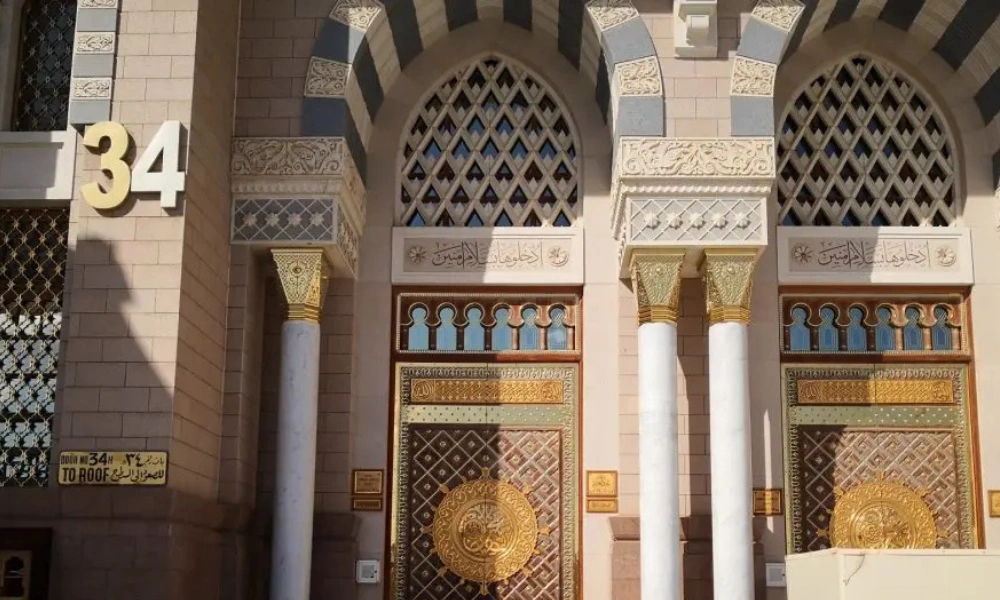
20. Gate 36 masjid al nabawi:
- Provides access to the rooftop of Masjid al-Nabawi via an escalator.
21. Bab Makkah (Gate No. 37):
- Named after the holy city of Makkah, this gate is one of two identical gates on the southern side of the mosque.
22. Bab Bilal (Gate No. 38):
- Named after Bilal ibn Rabah, the first muezzin of Islam.
- Located on the southern side of the King Fahad expansion, with four doors for entry.
23. Bab un Nisa (Gate No. 39):
- Meaning “the Gate of Women,” this gate was specially installed by Caliph Umar ibn al-Khattab for the exclusive use of female worshippers.
24. Bab Jibril (Gate No. 40):
- Named after the Angel Jibreel (Gabriel), who was believed to have entered the mosque through this gate.
- Also known as Bab un-Nabi or the “Gate of the Prophet.”
25. Bab al-Baqi (Gate No. 41):
- Named after the Baqee’ cemetery, located near the mosque.
- Situated close to the burial chamber of Prophet Muhammad ﷺ.
26. Bab ul-Aimmah/Aiymah (Gate No. 42):
- Meaning the “Gate of the Imams,” this small gate provides access to the Rawdah (Prophet’s Resting Place).
- Also known as Bab ul-Janaiz, or the “Gate of Funerals.”
27. Architectural Highlights and Amenities
The 42 gates of Masjid al-Nabawi boast a remarkable blend of historical significance and architectural grandeur. From the double-arched Hijrah Gate to the triple-arched Bab-e-Quba, each entryway exhibits unique features that captivate visitors. Additionally, the article highlights the nearby underground parking facilities, ensuring a seamless experience for those visiting the mosque.
Conclusion: A Journey through the Sacred Gateways
This comprehensive guide offers a profound exploration of the 42 gates that grace the Masjid al-Nabawi, shedding light on their historical significance, architectural marvels, and the distinct roles they play in facilitating the devotion of both men and women.
By delving into the intricate details of these hallowed portals, readers gain a deeper appreciation for the spiritual essence and legacy of this revered mosque. As visitors embark on their journey through these sacred gateways, they are imbued with a profound connection to the Prophet’s teachings and the timeless traditions of Islam.
